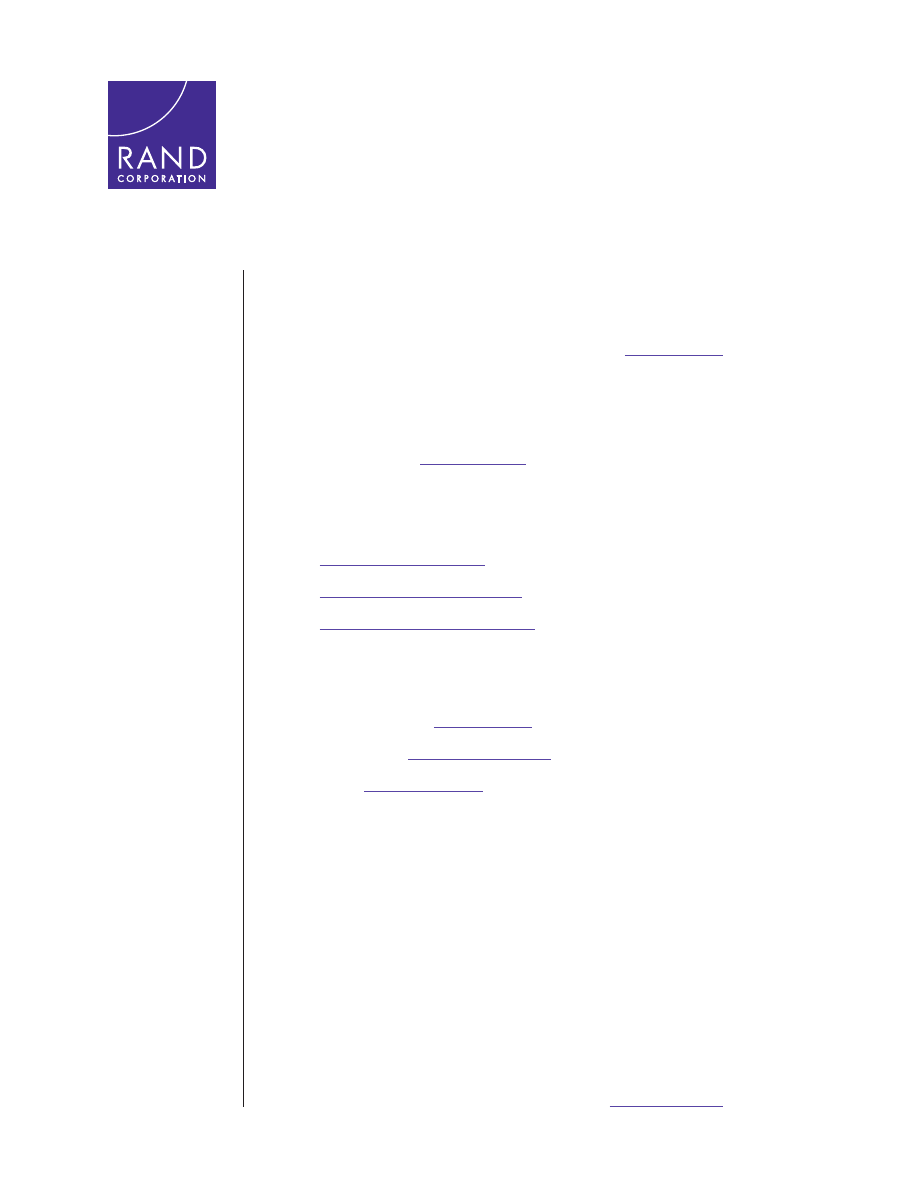
For More Information
Visit RAND at
Explore the
View
Support RAND
Purchase this document
Browse Reports & Bookstore
Make a charitable contribution
Limited Electronic Distribution Rights
This document and trademark(s) contained herein are protected by law as indicated in a notice appearing
later in this work. This electronic representation of RAND intellectual property is provided for non-
commercial use only. Unauthorized posting of RAND electronic documents to a non-RAND website is
prohibited. RAND electronic documents are protected under copyright law. Permission is required from
RAND to reproduce, or reuse in another form, any of our research documents for commercial use. For
information on reprint and linking permissions, please see
.
Skip all front matter:
The RAND Corporation is a nonprofit institution that helps improve policy and
decisionmaking through research and analysis.
This electronic document was made available from
as a public service
of the RAND Corporation.

This report is part of the RAND Corporation research report series. RAND reports
present research findings and objective analysis that address the challenges facing the
public and private sectors. All RAND reports undergo rigorous peer review to ensure
high standards for research quality and objectivity.
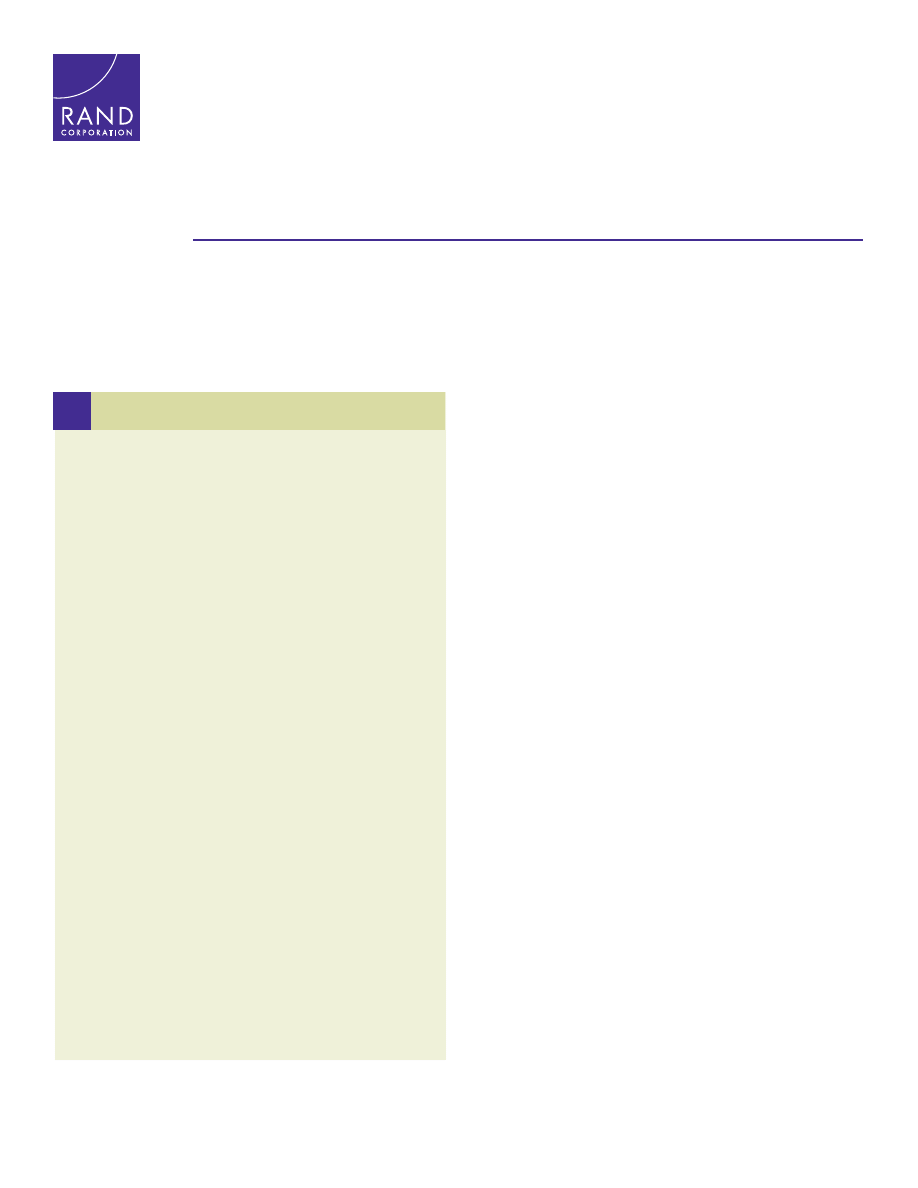
Sum m ary
■
Budget reductions and new defense
strategic guidance are causing the Army to reassess how
it balances the mix of forces between its active compo-
nent (AC) and its reserve components (RCs), the Army
National Guard and the U.S. Army Reserve. The Army
asked RAND to identify a set of considerations for poli-
cymakers and planners as they weigh future force mix
decisions. This report provides a focused look at portions
of an ongoing stream of RAND research on the Army’s
AC-RC force mix.
Cost is one factor to consider when weighing force
mix decisions, but it is not the only one, and it should
not be considered in isolation. Policymakers and planners
must also consider the capabilities that AC and RC forces
provide relative to what they cost. There is no one-size-
fits-all answer. Differences in capability and cost between
AC and RC forces depend on the type of unit—from large
ground combat and aviation units to smaller support and
logistics units.
One key aspect of capability is force output. This
report examines two critical aspects of output and cost.
The first is the time needed to make AC and RC forces
ready to deploy abroad in a crisis. The second is the rela-
tive costs of using AC and RC forces to provide a sustained
level of deployed forces on the ground for rotational
missions.
One RC unit generally costs less than a comparable
AC unit, largely because most RC soldiers are part-time
C O R P O R A T I O N
Assessing the Army’s Active-Reserve
Component Force Mix
Joshua Klimas, Richard E. Darilek, Caroline Baxter, James Dryden, Thomas F. Lippiatt,
Laurie L. McDonald, J. Michael Polich, Jerry M. Sollinger, Stephen Watts
• Force mix decisions must account for differences in
the capabilities that active and reserve components
provide, as well as differences in what they cost.
• In sustained operations, like Iraq and Afghanistan,
U.S. Department of Defense policy permits reserve
component (RC) units to deploy less often than active
component (AC) units; this means that it takes two or
more RC units to provide the same output as one AC unit.
• Because of the larger number of RC units needed, in
some cases it can be more expensive to provide the
same sustained output with RC units than with AC units.
• RC units must finish training after they mobilize, which
means they take longer to get ready to deploy in a crisis
compared with AC units that have completed training. In
some cases, RC units may not be able to finish training
and deploy in time to meet a commander’s needs.
• Differences in output and cost depend on the type of
unit: Many smaller RC units can get ready to deploy
relatively quickly after mobilization, and they are also
more likely to show a cost-per-output advantage for
sustained operations; larger RC ground combat and
aviation units take longer to complete postmobilization
training and can be more expensive for the same sus-
tained output than AC forces.
Key findings

and train less than AC soldiers. RC units generally need to finish training after they mobilize, which
means they cannot be ready to deploy as rapidly as AC units that have completed training. In short,
some of the factors that make RC units cost less also make them less ready to deploy in a crisis.
Global contingencies may occur with little or no warning, and they require forces that can respond
rapidly. Smaller RC units with support and logistics functions generally require less postmobiliza-
tion training and can be ready to deploy faster than larger RC units with combat missions. The
latter require more extensive collective training, as well as mastery of complex staff planning and
battle command functions. No large RC brigade combat teams (BCTs) or combat aviation brigades
have deployed as full brigades in the first year of a global contingency in more than 50 years, so it is
difficult to estimate the time needed to prepare these RC units for rapid response in a crisis. There
can also be limits on the number of RC units that can mobilize at one time, given such constraints
as available training space and number of trainers.
Law and policy limit how frequently AC and RC forces can deploy for sustained operations,
with RC forces available to deploy less frequently than their AC counterparts. This means it takes
more than one RC unit to provide the same sustained output—the same cumulative amount of time
spent on the ground performing missions—as one AC unit. While one RC unit generally costs less
than a comparable AC unit, multiple RC units may not. For smaller support and logistics units, for
example, the sustained output of RC forces can still cost less, even if two or more units are needed
to match the output of one AC unit. On the other hand, some types of units—such as some ground
combat, aviation, and other units with expensive equipment and training costs—can be more
expensive in the RC for the same level of sustained, given that more than one RC unit is needed to
match the output of one AC unit.
The bottom line is that simple one-to-one AC-RC cost comparisons are insufficient to inform
force mix decisions. Measures that combine capability and cost are more useful when weighing the
AC-RC force mix.
AC-RC force mix decisions must consider both capability
and cost.
2

multiple FactorS Should
inFluence active-reServe Force
mix deciSionS
Cost is one factor, but it is not the only one, and it should not
be considered in isolation. Policymakers and planners must also
consider the capabilities that AC and RC forces provide relative
to what they cost. Capability considerations include potential
differences in the time needed for AC and RC forces to become
ready to deploy in a crisis, how often and for how long forces
can be deployed, and how effective they are. Some capability
differences between AC and RC forces depend on the mission
or the type of unit. For example, smaller RC units with support
and logistics functions will generally be able to respond faster in
a crisis than larger RC units with combat missions. Other capa-
bility differences may apply across the board, regardless of the
unit type or mission. For example, current law and policy limit
how frequently AC and RC forces can mobilize and deploy,
with RC forces typically available less frequently than their
AC counterparts, regardless of unit type. A holistic assessment
encompassing the range of capability and cost factors would
permit the fullest, risk-informed assessment of the Army’s
AC-RC force mix to identify the options that provide the most
value—that is, the needed capability at the lowest cost.
To assist policymakers and planners in weighing the factors
that should inform force mix decisions, this report highlights
two planning considerations. The first involves the time needed
to make AC and RC forces ready to deploy abroad in a crisis
with little or no advance warning, which we term surge avail-
ability. The second involves the relative costs of employing AC
and RC forces to provide the same level of sustained output—
the same amount of deployed force on the ground—for rota-
tional missions. This second planning consideration accounts
for the fact that RC forces are available to deploy less frequently
than their AC counterparts, which means that it takes more
than one RC unit to provide the same sustained output as a
comparable AC unit.
Our analysis does not address the topic of mission effec-
tiveness. We assume that once units are trained and made
ready for deployment, AC and RC units of the same type will
be capable of performing their assigned missions on a compa-
rable basis. In practice, there may be differences in AC and RC
effectiveness for certain missions, but we did not address this
topic in our research. When we consider unit costs as a factor in
our analysis, we assume that AC and RC units of the same type
are provided with the same number of personnel and the same
amount and types of equipment.
the impact oF Str ategic
and Budgetary changeS on
the army’S active-reServe
Force mix deciSionS
Before the 9/11 terrorist attacks, U.S. Department of Defense
(DoD) planners focused primarily on large-scale major combat
operations as the key driver of Army force requirements. Opera-
tions in Iraq and Afghanistan changed this paradigm: DoD
planners began to expand their focus to the requirements for
sustaining rotational deployments in the aftermath of a major
combat operation. With the withdrawal from Iraq complete
and in the midst of the drawdown in Afghanistan, DoD is
again shifting the focus of its ground force planning. The 2012
defense strategic guidance document emphasizes deterring or
defeating aggression—through major combat operations, if
necessary—as the key mission for sizing most types of Army
forces.
1
Major combat surge operations may occur with little or
no advance warning. Therefore, the speed with which ready AC
and RC forces can deploy to meet unanticipated surge demands
is a key consideration in force planning.
The document also directs that “U.S. forces will no longer
be sized to conduct large-scale, prolonged stability operations”
(p. 6). Nevertheless, the document specifies that stabilization
and counterinsurgency missions remain relevant to force plan-
ning. In particular, U.S. military forces must be “able to secure
territory and populations and facilitate a transition to stable
governance on a small scale for a limited period using standing
forces and, if necessary, for an extended period with mobi-
lized forces” (p. 4). Therefore, sustained operations of at least
Differences in capability
and cost between AC and
RC forces depend on the
type of unit.
3

some magnitude will remain relevant for force sizing and mix
decisions. Moreover, the United States is engaged in ongoing
operations outside Afghanistan—in the Persian Gulf, Kosovo,
Sinai, the Horn of Africa, and elsewhere—and potential new
security cooperation missions in other regions could involve the
rotation of ground forces. In short, while a need to surge forces
for potential future major combat operations may once again
drive total Army force size decisions, the mix of forces required
for sustained operations—and the relative cost of AC and RC
forces in providing sustained output—remains a relevant plan-
ning consideration.
WayS to thinK aBout the
output that active and reServe
component ForceS provide For
their coSt
There are a number of ways to think about the output that
AC and RC forces provide for their respective costs
.
One way
is to assume that AC and RC units are identical in terms of
output—that is, to assume that an RC unit of a given type is
interchangeable with an AC unit of the same type, with no
difference in areas such as the time needed to become ready
to deploy in a crisis, the frequency of deployment for sus-
tained missions, or mission effectiveness. This way of thinking
assumes that the key difference between AC and RC units is
in their operating cost (e.g., pay, training, support), which is
lower, on average, for RC units.
We found that simple one-to-one unit cost comparisons
of AC and RC units are fundamentally flawed in that they fail
to account for differences in the output that AC and RC units
provide. The outputs we focus on in this report include (1) the
time needed for units to become ready to deploy abroad in a
crisis and (2) how frequently units are available to deploy over
time. Again, we do not address potential differences in effec-
tiveness between AC and RC units.
An RC unit’s operating costs are lower, on average, largely
because RC units train less than full-time AC units. This differ-
ence in AC-RC training time can lead to a difference in AC-RC
responsiveness in a crisis. Because they train less, RC units gen-
erally require longer response times in a crisis than comparable
full-time AC units. Moreover, at least in the context of current
law and DoD policy, RC forces are expected to deploy less
frequently than AC forces to sustained operations, and they may
deploy for shorter periods. They are therefore able to provide less
output over time than their AC counterparts.
These constraints on RC units are understandable, given
the responsibilities RC soldiers have to states, communities, and
employers. By design, they are not full-time soldiers. However,
these constraints should also factor into the thinking about
the output that AC and RC forces provide. Other factors are
relevant when considering the AC-RC mix. For example, the
Army National Guard plays a key role in critical homeland
defense and civil support missions, and the unit-level require-
ments for performing such missions should be a consideration
in the overall AC-RC force mix as well.
The upshot is that cost, while a relevant factor, should not
be considered in isolation. Military planners and policymakers
must also weigh the advantages and disadvantages of AC and
RC forces in providing combatant commanders and homeland
authorities with the capabilities they require: ready and proficient
forces on the ground at the time and in the quantity they need.
active and reServe component
availaBility For Surge miSSionS
Because RC units generally need additional training and prepara-
tion time after mobilization but before they deploy, the amount
of warning the United States can expect before deploying forces
is an important factor in decisions about the active and reserve
force mix. In some cases, the Army has had ample time to
prepare its forces (e.g., the two world wars). In other cases, it has
had virtually no warning and minimal preparation time before
beginning large-scale troop deployments (e.g., the Korean War).
More recently, it had some time to prepare for large-scale major
combat operations in Iraq (both in 1991 and 2003). On the other
hand, the initial Iraqi invasion of Kuwait in 1990 took the nation
by surprise, as did the events of September 11, 2001. The fact
that only a relatively small force was used in Afghanistan in the
months after 9/11 does not obviate the conclusion that surprises
requiring the rapid deployment of ground forces are possible.
Moreover, if Iraqi forces had continued into Saudi Arabia after
occupying Kuwait in 1990, this might have necessitated a more
rapid deployment of U.S. forces for major combat operations
than actually occurred. In short, while not all future contingen-
cies will be unexpected, some will be. Planners and policymakers
should consider short-notice, rapid-response surge missions as
one factor in weighing AC-RC mix decisions.
4
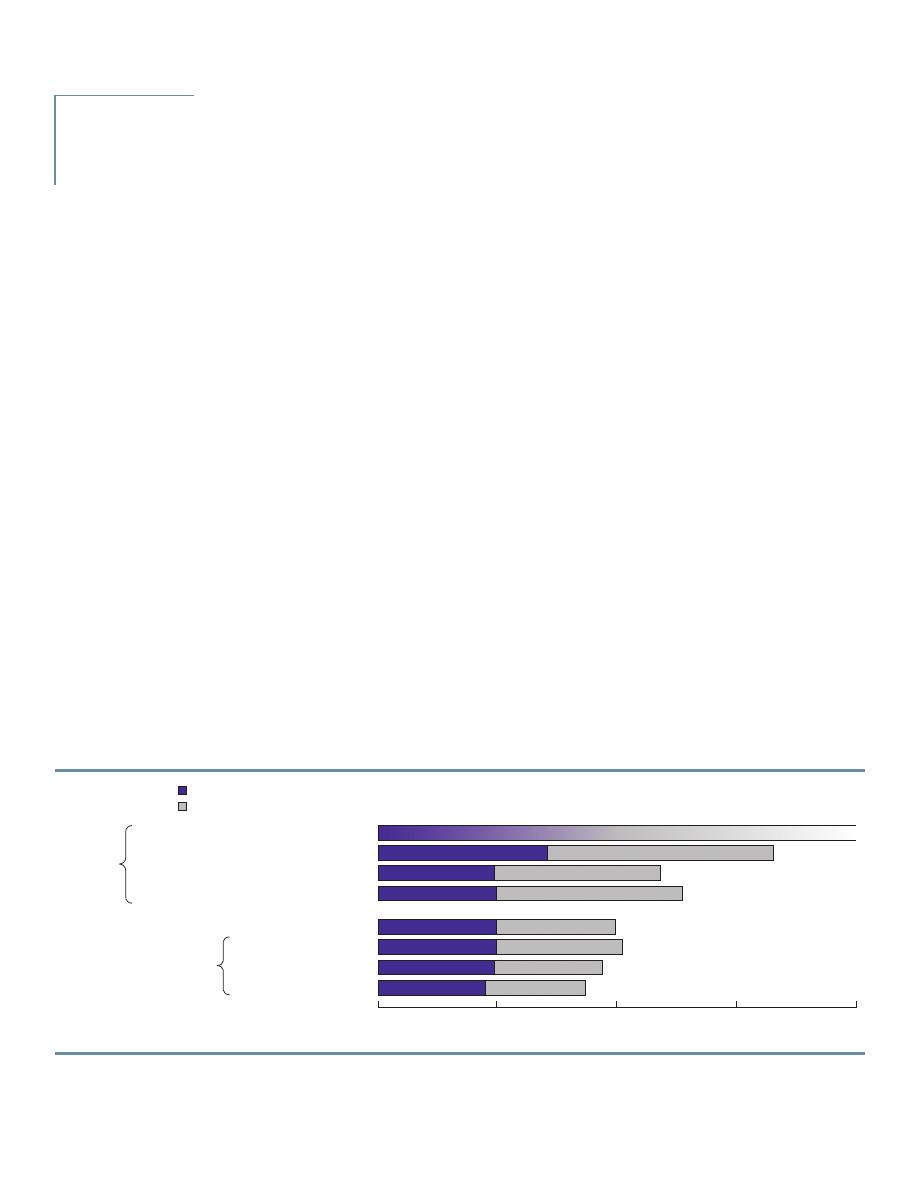
When it comes to surge operations, the answers to several
key questions will influence the AC-RC mix:
•
How much warning time is there before the start of surge
operations, and when do leaders start the mobilization
process?
•
When do commanders need forces in theater, and what
missions must these forces be ready to perform?
•
When can units be trained and ready to go?
When warning time is short or the decision to mobilize
is delayed, and commanders need forces to deploy rapidly at
high readiness for complex missions, AC forces often have an
advantage. This is because RC units generally require additional
preparation time after mobilization but before they deploy.
For some unit types, particularly smaller support and logis-
tics units, this added preparation time may be relatively brief.
For example, in both Operation Desert Shield/Desert Storm
(1990–1991) and Operational Iraqi Freedom (2003), there were
multiple instances of smaller RC support and logistics units
mobilizing and deploying in times comparable to some AC
units of the same type.
On the other hand, larger RC combat units (e.g., BCTs,
combat aviation brigades) can require substantial postmobili-
zation preparation before deployment. Not all AC units will
be ready to deploy immediately, either, due to the design of
the Army Force Generation system. However, Army readiness
models indicate that up to half of Army AC units should be
ready to deploy on short notice, with additional units becoming
ready in the following weeks and months. In contrast, even the
most ready RC units will often need at least some additional
preparation after mobilization, which, in turn, may limit or
prevent the deployment of substantial RC forces of certain
types in the time frame that commanders request.
How much additional postmobilization preparation will
RC units need in the event of a short-notice surge? The answer
depends on a complicated set of variables, and historical response
times may not match future events. However, data from the past
few years illustrate key factors that affect RC preparation times.
Figure 1 shows the average time that different types of RC units
(Army National Guard and U.S. Army Reserve) spent prepar-
ing to deploy to Iraq or Afghanistan between 2008 and 2010,
both in the year before mobilization (purple) and after they were
Policymakers must consider differences in how rapidly AC
and RC forces can be ready to deploy overseas in a crisis.
Unknown
87
94
102
99
127
118
165
0
50
100
150
200
Category 1 (inside wire)
Category 2 (intermediate)
Category 3 (outside wire)
Enabler battalion headquarters
Advising/training (5 deployments)
Security forces (12 deployments)
Counterinsurgency (2 deployments)
Combined arms maneuver (no deployments)
Preparation days
Premobilization preparation days (within 365 days prior to mobilization; includes typical 39 training days)
Postmobilization preparation days (mobilization date to arrival in theater)
Figure 1. Average predeployment preparation times, reserve component, 2008–2010
SOURCE: Analysis of personnel data from the Defense Manpower Data Center.
NOTE: “Outside the wire” refers to units that operate outside the confines of operating bases in more hostile environments and thus require more predeployment
training. The figure reflects the 39 days of training that an RC unit executes in a typical year.
BCTs
Enabler
companies
5

mobilized but before they arrived in theater (gray).
2
The purple
bars include the 39 days that RC units typically train in a year
when not mobilized. The gray bars include all time and activities
between mobilization and arrival in theater (including time in
transit to theater), not just training time.
The figure shows that the average amount of time that RC
units spent preparing for deployment depended on the unit
type, the mission, and the operational environment to which
they deployed. RC BCTs spent longer preparing than did com-
pany-sized or smaller support and logistics units (“enablers,” as
the Army calls them).
3
Enabler units operating in more threat-
ening environments took longer to prepare. BCT preparation
times depended on the nature of the mission. Units deploying
to counterinsurgency missions took longer than those deploy-
ing as security forces or trainers.
4
There are essentially no
historical data indicating the amount of time it takes to prepare
and rapidly deploy an RC combat brigade for brigade-level
combined arms maneuver—not just since 2008 but going back
more than 50 years.
5
Although precise forecasts of future RC preparation
times for a short-notice surge contingency are not possible,
overall trends in the historical data should hold. In general,
RC company-sized units will require less postmobilization
preparation and thus will be able to deploy more rapidly than
battalion or brigade-level combat units. Preparing for integrated
brigade-level combined arms maneuver is the most complex
and challenging mission set for an Army maneuver brigade.
Postmobilization preparation times for RC combat brigades
preparing for such missions would, therefore, likely exceed the
preparation times shown in the figure for counterinsurgency
missions. Moreover, RC units of all types achieved the post-
mobilization preparation times shown by doing much of their
individual training and preparation activities—and some-
times a portion of their collective training as well—in the pre-
mobilization year. In a future short-notice surge contingency,
RC units may need to do even more training after mobiliza-
tion than shown in the figure. The Army could invest in extra
annual training days for certain RC units to shorten their
postmobilization preparation times, but this would add to the
cost of these units; the more they train per year, the closer their
costs come to those of AC units.
In short, the factors that make RC units cheaper, on aver-
age, than AC units also tend to make them less ready for rapid
deployment in a crisis. This tendency particularly affects large
units performing complex missions. Thus, constraints on the
time it takes to ready RC forces to deploy must be balanced
against their lower average costs.
In addition, policymakers and planners must consider
constraints on the Army’s mobilization throughput capacity, in
terms of both available trainers and training space. Simply put,
there is a limit on how many RC units the Army can mobilize
at one time. For example, there are only two combat training
centers in the United States to support AC and RC brigade-
level training for combined arms maneuver. While this may
not affect the preparation time for an individual RC unit, it can
affect the total number of RC units that can be mobilized and
deployed in time to meet combatant commanders’ needs.
active and reServe component
coStS to produce equal output
For SuStained oper ationS
The combined demands for forces in Afghanistan and Iraq
since 2003 provide the best example of large-scale sustained
operations. While recent defense guidance has minimized
the role of such missions in the overall sizing of forces, it still
recognizes that these missions should influence the force mix.
In practice, moreover, at least some level of global rotation of
forces should continue for the foreseeable future, regardless of
the ultimate drawdown in Afghanistan. Therefore, the output
of forces in sustained rotational operations should continue to
be a factor in how the Army assesses its overall mix of forces.
When considering the force mix implications of sustained
rotational missions, the relevant consideration is not individual
AC and RC unit costs but instead the cost to deliver the same
amount of output to commanders on the ground—what we refer
to as equal “boots-on-the-ground” output. This definition of out-
put focuses on time spent on the ground performing missions and
does not address potential differences in effectiveness between AC
and RC units. We assume that when units are trained and ready
they are effective at performing assigned missions.
In light of the laws and policies that currently govern
their use, Army RC forces deploy less frequently than their
AC counterparts. Moreover, under some rotation policies, RC
units deploy for shorter periods than AC units. As a result, it
takes more than one RC unit to produce the same boots-on-
the-ground output as one AC unit. Figure 2 demonstrates why
multiple RC units are needed to match the sustained output of
one AC unit.
6
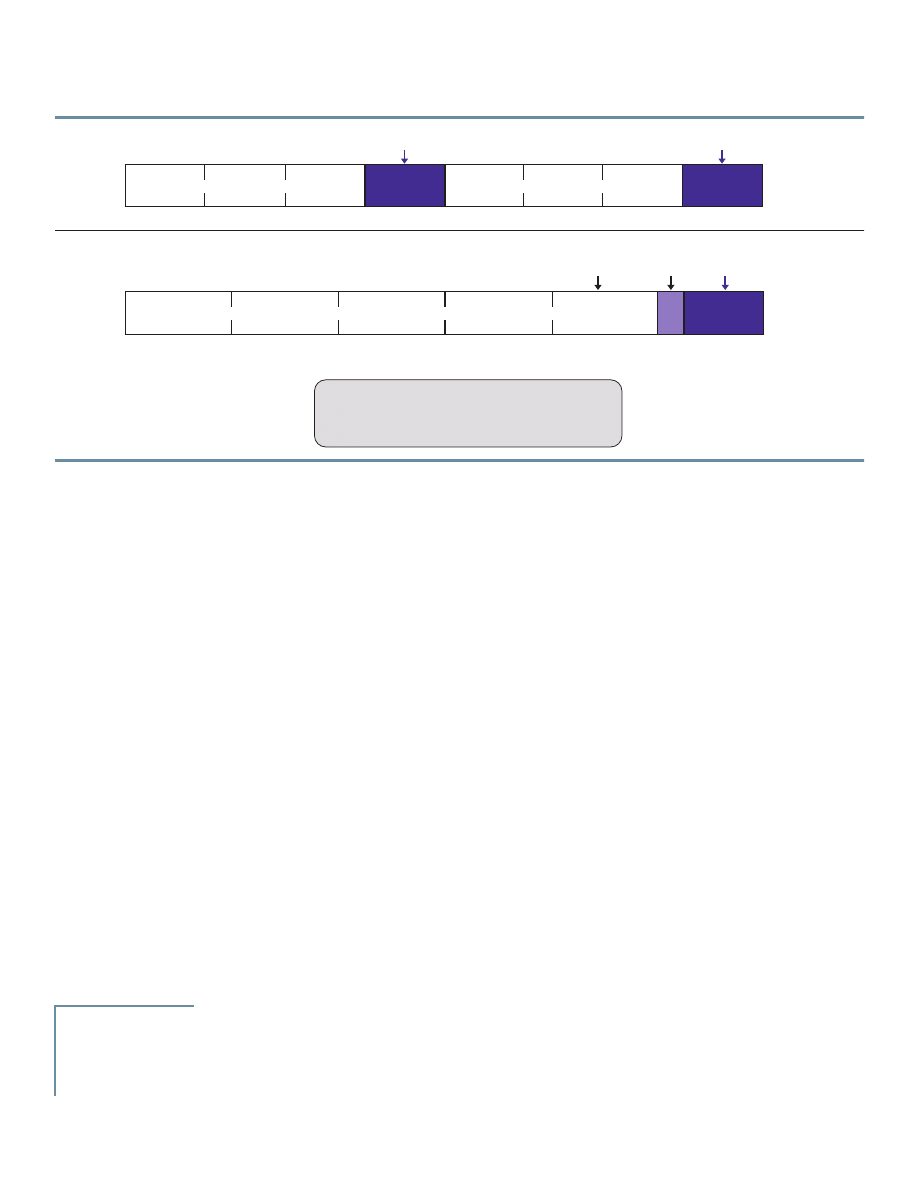
The illustration starts by assuming the Army’s historically
preferred rotation rates:
6
•
AC units: a three-year cycle, including 27 months dwell
and nine months deployed (1:3)
•
RC units: a six-year cycle, including five years dwell and
one year mobilized (1:5).
Our analysis uses these rates to calculate units’ output over
an extended period (six years, or 72 months, in this example).
The AC unit in the top part of the figure is available to deploy
for nine months out of every three years, for a total of 18
months of output over six years. The RC unit is available to
mobilize for 12 months (as set by DoD guidance) out of every
six years. However, the 12-month mobilization period includes
time when the unit is preparing for deployment but is not yet
in theater performing the mission. For the purposes of this
illustration, we have assumed that RC units need about three
months of preparation after mobilization but before deploy-
ment. As a result, the RC unit produces nine months of output
during the six-year period.
7
Therefore, it takes two RC units to
generate the same 18 months of output as one AC unit if the
rotation rates are 1:3 and 1:5.
8
Different rotation rates can produce variations in the output
of RC and AC units. The gray box at the bottom of the figure
includes the results for faster and more stressful rotation rates,
which are based on either Army or Office of the Secretary of
Defense (OSD) planning factors for periods of high sustained
demand and which are closer to the stress that many units expe-
rienced over the past decade than are the Army’s preferred rates
described above. At these faster rotation rates, it takes more than
two RC units to match the output of one AC unit. For example,
at rotation rates of 1:2 and 1:4 (often described by the Army as
“surge” rotation rates), it takes 2.3 RC units to produce the same
output as one AC unit. However, such a scenario would rotate
RC units faster than DoD guidance specifies; for purposes of
force planning, DoD’s objective RC rotation rate is 1:5. The third
Deployment
9 months
Post-
mobilization
preparation
Pre-
mobilization
preparation
Reserve component
Deployment
9 months
9 months
Deployment
Active component
0
36
72
9
18
27
45
54
63
Total deployment
time:18 months
Total deployment
time: 9 months
0
72
3
mo
36
12
24
48
60
Rotation rate (AC/RC) Number of RC units needed
Month:
Month:
63
For output equal to 1 AC unit
1:3 / 1:5
1:2 / 1:4
1:2 / 1:5
2.0
2.3
2.7
Dwell (27 months)
Dwell (27 months)
Dwell (60 months)
Figure 2. Notional active component unit rotating at 1:3 and reserve component unit rotating at 1:5
NOTE: The figure assumes the Army’s historically preferred rotation rates: a three-year cycle, including 27 months of dwell and nine months deployed, for AC
units (1:3) and a six-year cycle, including five years of dwell and one year mobilized, for RC units (1:5).
Under current policy for sustained operations, it takes two
or more RC units to provide the same output as one AC unit.
7

row in the box shows the result if RC units were constrained
to 1:5 while AC units rotated at 1:2. In that case, it would take
2.7 RC units to produce the same output as one AC unit.
The fact that it takes two or more RC units to match the
output of one AC unit translates directly into our calculations
of AC and RC output costs.
9
These calculations include mili-
tary personnel costs but also factor in training, support, equip-
ment, and other costs. To calculate these costs, we identified
three cost categories: annual operations and support (O&S),
equipment, and, for RC units, mobilization. Our analysis
assumes that RC units are equipped to the same standard as
AC units, so per-unit equipment costs are the same for each.
10
Alternate equipping practices that provide one component
with lower average quantities, modernization levels, or both
could profoundly affect relative AC-RC equal-output costs.
However, this would also affect the relative capabilities and
readiness of the components.
Our analysis shows that cost differences between AC and
RC units are not uniform across the board; they vary by unit
type. For example, there is a greater cost difference between
an RC military police combat support company and its AC
counterpart than there is between an RC AH-64 attack heli-
copter battalion and its AC counterpart. The second and third
columns of Table 1 show the annual cost of one AC and one
RC military police combat support company. The AC unit has
higher O&S costs in part because it trains more during the
year, but the equipment costs are the same. Only the RC unit
has mobilization costs; although these costs apply only to the
period when the unit is mobilized or preparing for mobiliza-
tion, the table averages them over a six-year cycle. The fourth
and fifth columns compare average annual costs for equal
output if AC units rotate at 1:3 and RC units rotate at 1:5. In
this case, two RC units are needed to match the output of one
AC unit. Even in this example, two RC units cost less than one
AC unit. How much less depends on whether the RC units are
regularly mobilized. If not mobilized, they cost about 63 per-
cent of an AC unit; if they are mobilized, they cost about
92 percent of an AC unit.
However, the case changes for units with high equipping
and training costs, such as an AH-64 attack helicopter battalion.
Table 2 compares the costs of AC and RC AH-64 battalions.
When compared on the same equal output basis shown for the
military police combat support companies, two RC AH-64
battalions cost 107 percent as much as an AC unit when
not mobilized and 126 percent if mobilized. In other words,
two RC AH-64 battalions cost more than one AC battalion,
whether regularly mobilized or not.
relative reserve component–active
component equal output costs across
unit types
We have illustrated the cost results for two selected types of
units, but how do those two cases fit into the overall picture
for a wide selection of units? Figure 3 shows cost calculations
for 237 unit types, following the same methodology used for
the military police combat support companies and the AH-64
attack helicopter battalions. Here, AC units rotate at 1:3 and
RC units at 1:5. At these rotation rates, the RC often—but not
always—provides equal output for less cost.
The vertical axis reflects the cost of RC output relative to
the cost of AC output for a given unit type. The horizontal
line represents the point of equal RC and AC output cost for
sustained rotation. Above this line, RC output is more expen-
sive than AC output; below it, RC output is less expensive.
The vertical bars represent 237 Army unit types, sorted from
highest to lowest according to RC-to-AC cost ratio. Several
specific unit types are called out with labels: AH-64 battalions;
armored, Stryker, and infantry BCTs; certain types of military
police companies and engineer companies; and so forth. The
color-coding is dark blue for O&S costs, gold for equipment
costs, and purple for RC mobilization costs.
In interpreting the graph, note that it presents two
“bookends” on AC-RC equal output costs. The first and lower
bookend represents the relative cost to maintain RC units but
not the cost to mobilize them (the combination of the dark blue
and gold regions, representing annual O&S and equipping costs,
respectively). The second and higher bookend represents the cost
to mobilize the RC units (the combination of the dark blue, gold,
and purple regions in the figure, representing RC mobilization-
related costs in addition to annual O&S and equipping costs).
How could these bookends be of use to planners as they
consider the force mix implications of sustained rotational mis-
sions? If the focus is on meeting demand in ongoing operations,
for example, then planners should consider the higher bookend
on AC-RC equal output costs because an RC-focused force
would need to mobilize regularly to meet demand. On the other
hand, if ongoing demand is comparatively low but planners
wanted to maintain a sufficient supply of forces to be able to meet
future sustained demand in the aftermath of a major contin-
8
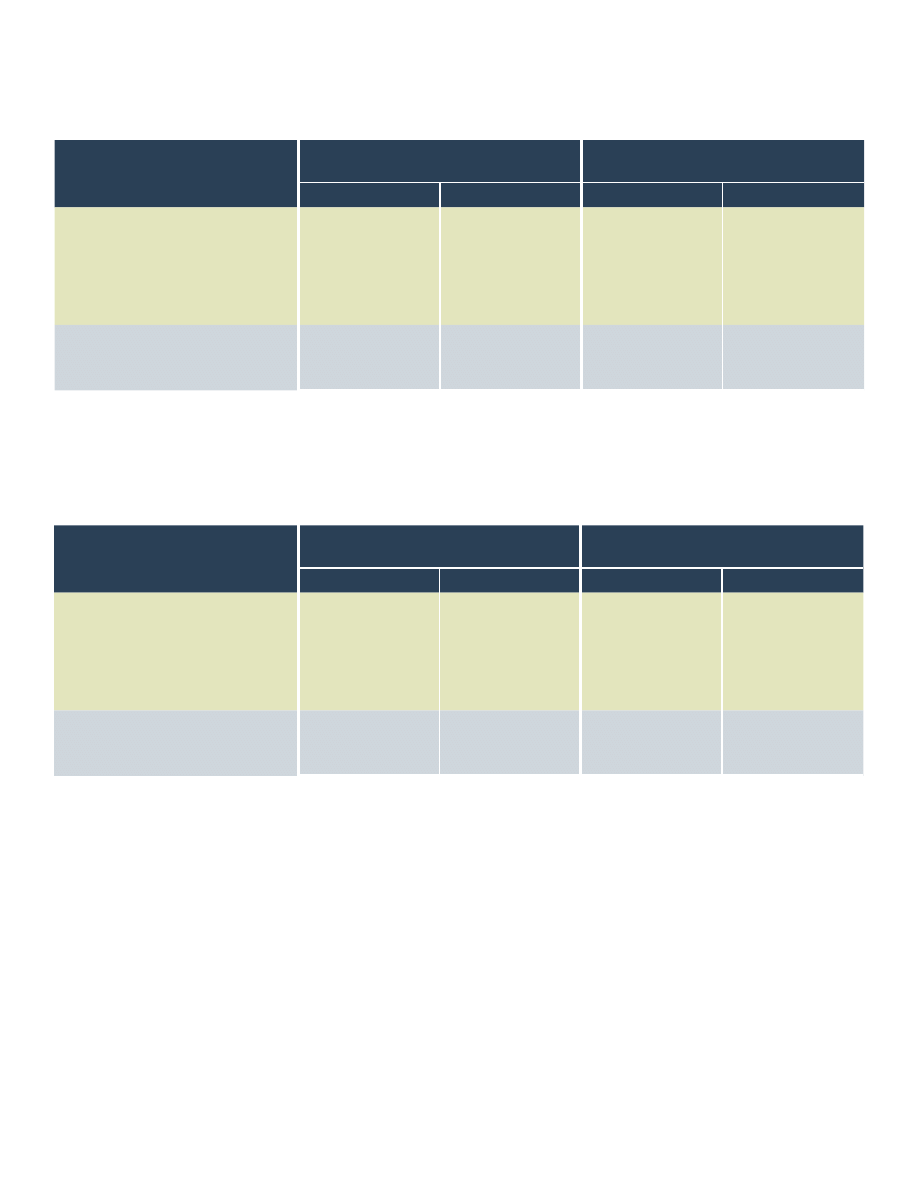
gency operation, then they could consider the lower bookend on
AC-RC equal output costs. This is because many RC units might
not need to mobilize regularly to meet ongoing demand, and RC
mobilization costs over the near term would be comparatively
low. In these circumstances, most RC unit output would be held
“in reserve” for future support to a major contingency.
The figure shows that at rotation rates of 1:3 (AC) and
1:5 (RC), the equal output cost ratio favors the RC for most
types of units, regardless of which bookend is used. That is, the
total RC-to-AC cost ratio is lower than 100 percent for most
unit types, regardless of whether RC units mobilize. However,
the cost advantage tends to be greater for company-sized and
smaller unit types, while larger battalion- and brigade-sized
units have less or no cost advantage for equal output. For
example, two RC Stryker BCTs are essentially the same cost
as one AC unit of the same type (with the point resting almost
precisely on the 100-percent line) if the RC units are regularly
mobilized. Most points to the right of the Stryker BCT fall
below the 100 percent line, including infantry BCTs, most
types of military police, engineer and transportation compa-
nies, and so forth. If RC units are not regularly mobilized, the
RC cost advantage for most unit types is more pronounced.
table 1. cost comparison of active and reserve component military police combat support companies
($ millions)
Simple one-to-one
unit cost comparison
comparison of cost
for equal output
cost element
1 ac unit
1 rc unit
1 ac unit
2 rc units
Annual O&S costs
$16.9
$4.5
$16.9
$9.1
Annual equipment costs
$1.1
$1.1
$1.1
$2.2
Annual RC mobilization costs (one
mobilization averaged over 6 years)
—
$2.6
—
$5.2
Total cost if RC unit is not mobilized
$18.0
$5.6
$18.0
$11.3 (63% of AC)
Total cost if RC unit is mobilized
$18.0
$8.2
$18.0
$16.5 (92% of AC)
SOURCE: Analysis of cost data from the Army FORCES Cost Model.
NOTE: O&S includes military personnel, direct and indirect training support, base operations, and the Defense Health Program. Equipping costs are spread over
30 years. RC mobilization includes incremental O&S costs during premobilization and mobilization, plus accrued leave. The comparison of equal output costs
reflects the Army’s preferred rotation rates of 1:3 (AC) and 1:5 (RC).
table 2. cost comparison of active and reserve component ah-64 attack helicopter battalions ($ millions)
Simple one-to-one
unit cost comparison
comparison of cost
for equal output
cost element
1 ac unit
1 rc unit
1 ac unit
2 rc units
Annual O&S costs
$69.5
$26.7
$69.5
$53.5
Annual equipment costs
$22.9
$22.9
$22.9
$45.9
Annual RC mobilization costs (one
mobilization averaged over 6 years)
—
$8.6
—
$17.1
Total cost if RC unit is not mobilized
$92.4
$49.7
$92.4
$99.4 (107% of AC)
Total cost if RC unit is mobilized
$92.4
$58.2
$92.4
$116.5 (126% of AC)
SOURCE: Analysis of cost data from the Army FORCES Cost Model.
NOTE: The comparison of equal output costs reflects the Army’s preferred rotation rates of 1:3 (AC) and 1:5 (RC).
9
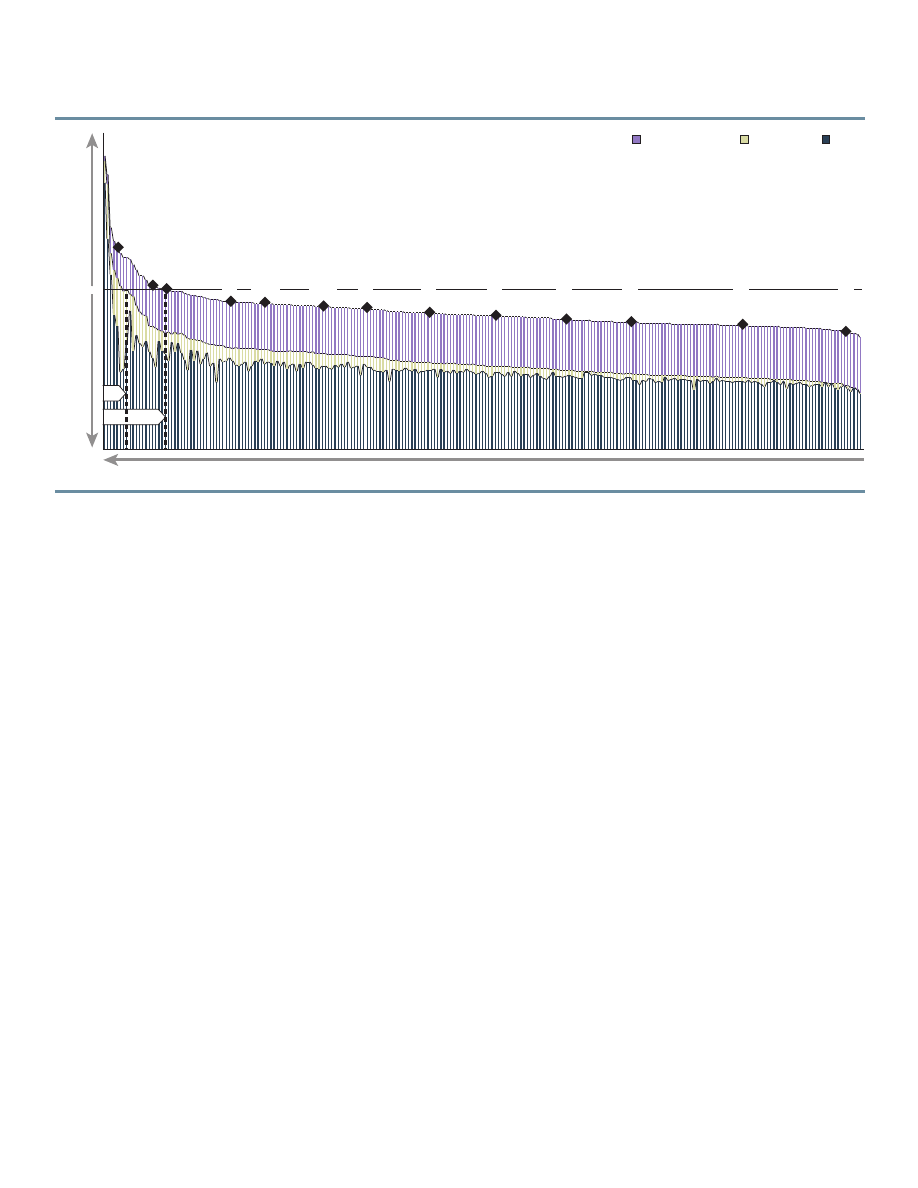
However, for some notable types of units—those with
high equipping and training costs—the RC cost is higher than
the AC cost. The figure calls out two such unit types: armored
BCTs (if RC units are mobilized) and AH-64 helicopter bat-
talions (whether or not RC units are mobilized). These unit
types have higher-than-normal equipment costs and everyday
training and support costs. As indicated by the white tabs at the
bottom of the figure, these more expensive unit types represent
10 percent of all unit types if RC units are mobilized or 3 per-
cent of all unit types if the RC units are not mobilized.
Figure 4 shows a contrasting situation, based on rotating units
at faster rates: 1:2 (AC) and 1:4 (RC), which the Army describes
as surge rotation rates for planning purposes. These rates are closer
to what many units have experienced over the past decade; in fact,
many types of AC and RC units rotated at rates even faster than
1:2 and 1:4, respectively, at least for some period of time.
11
At 1:2 (AC) and 1:4 (RC), it takes 2.3 RC units to produce
output matching one AC unit. Accordingly, moving from lower
to higher rotation rates changes the cost picture materially.
First, many more types of units are more expensive in the RC
for equal output, particularly in circumstances in which RC
units are mobilized. On the left side of the figure, many points
fall above the line representing the RC-to-AC cost ratio. For
example, all types of BCTs (armored, Stryker, and infantry) are
more expensive in the RC for sustained output when mobilized,
as are most types of support and logistics units, including many
that have been used widely in recent operations (e.g., military
police, engineer, truck, and signal companies).
Altogether, 67 percent of Army unit types are more expen-
sive in the RC than in the AC on an equal output basis when
RC units are mobilized. In many cases, the cost difference
between the AC and the RC is fairly small—a few percentage
points. However, some types of units are far more expensive in
the RC, including AH-64 battalions and armored and Stryker
BCTs. On the other hand, if RC units are not mobilized, only
6 percent of unit types cost more in the RC for equal output.
In 2007, then–Secretary of Defense Robert Gates issued
a policy that military services should not plan to mobilize RC
units more frequently than once every six years.
12
If AC units
rotate at 1:2 but RC units rotate at 1:5 instead of 1:4, it would
take 2.7 RC units to produce the same output as one AC unit.
Figure 5 shows the results for this case.
Under these conditions, nearly all unit types are more
expensive in the RC for equal output when RC units are mobi-
Figure 3. Comparison of active and reserve output costs at Army-preferred rotation rates
SOURCE: RAND analysis of cost data from the Army FORCES Cost Model.
NOTE: The figure shows 237 unit types and assumes a 1:3 rotation rate for AC units and a 1:5 rotation rate for RC units. Costs above the line indicate that 2 RC
units cost more than 1 AC unit for the same output. CO = company.
Re
ser
ve
o
ut
pu
t
co
st
s m
ore
Re
ser
ve
o
ut
pu
t
co
st
s l
ess
Decreasing cost advantage in the RC
A
H
-6
4 b
at
ta
lio
n
St
ry
ke
r B
C
T
A
rm
ore
d B
C
T
10%
3%
M
ilit
ar
y P
ol
ic
e c
om
ba
t
su
pp
or
t CO
Q
ua
rter
m
as
ter
C
O
(fi
el
d ser
vi
ce
)
Si
gn
al C
O (
ne
tw
or
k)
M
ed
ic
al
C
O
(l
ogis
tic
s)
Fi
na
nce
d
etac
hm
en
t
Tr
ans
po
rta
tio
n C
O (
ca
rg
o)
En
gi
ne
er C
O (
ho
rizo
nt
al
con
st
ru
ct
ion
)
In
fan
try
BC
T
RC mobilization Equipment O&S
Pu
bli
c a
ffa
irs
d
et
ac
hm
en
t
Co
nt
ra
ct
in
g t
ea
m
10
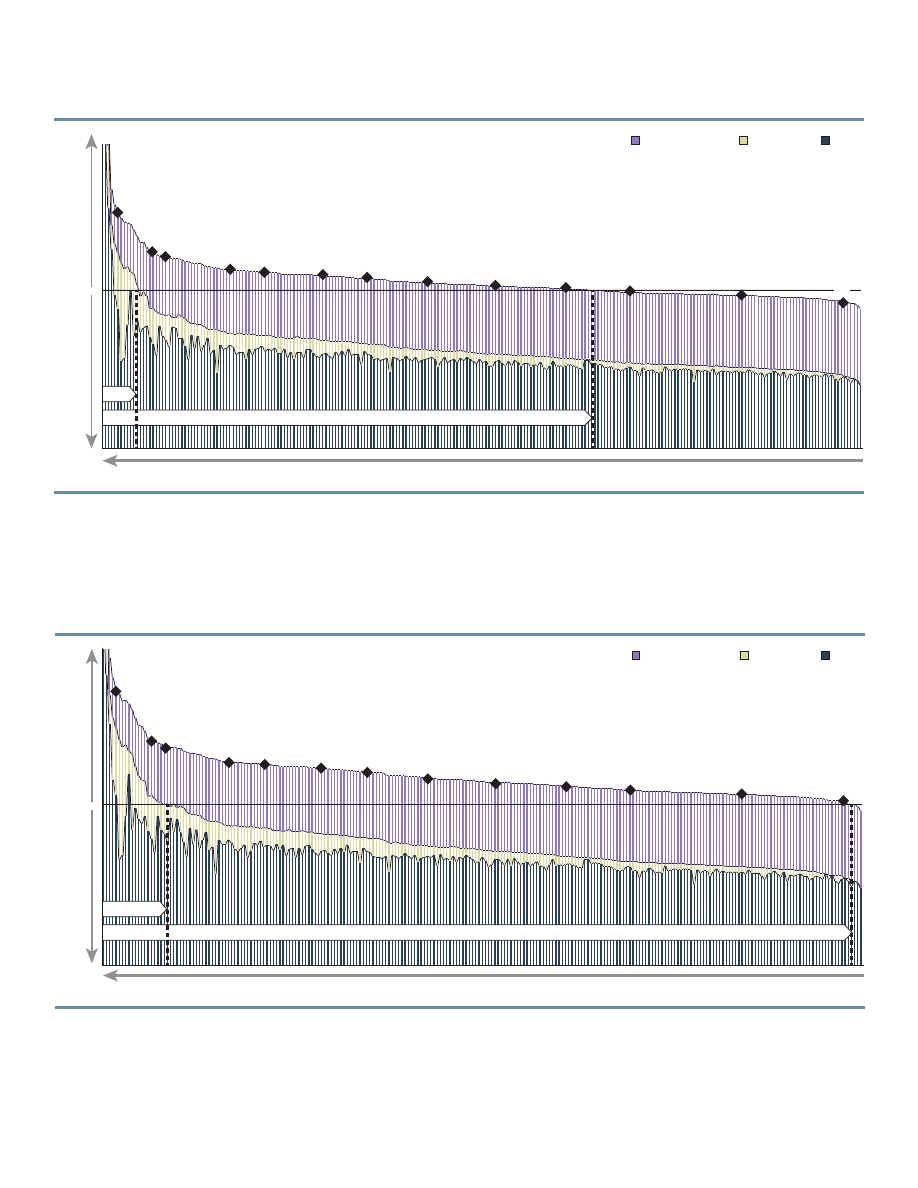
SOURCE: RAND analysis of cost data from the Army FORCES Cost Model.
NOTE: The figure shows 237 unit types and assumes a 1:2 rotation rate for AC units and a 1:4 rotation rate for RC units. Costs above the line indicate that 2.3
RC units cost more than 1 AC unit for the same output.
Re
ser
ve
o
ut
pu
t
co
st
s m
ore
Re
ser
ve
o
ut
pu
t
co
st
s l
ess
Decreasing cost advantage in the RC
AH
-6
4
ba
tta
lio
n
Pu
bli
c a
ffa
irs
d
et
ac
hm
en
t
St
ry
ke
r B
C
T
A
rm
ore
d B
C
T
67%
6%
M
ili
ta
ry
P
oli
ce
c
om
ba
t
su
pp
or
t C
O
Q
ua
rte
rm
as
te
r C
O (
fie
ld
ser
vi
ce
)
Si
gn
al C
O (
ne
tw
or
k)
M
ed
ic
al
C
O
(l
ogis
tic
s)
Fi
na
nce
d
etac
hm
en
t
Tr
ans
po
rta
tio
n C
O (
ca
rg
o)
En
gi
ne
er C
O (
ho
rizo
nt
al
con
st
ru
ct
ion
)
In
fan
try
BC
T
RC mobilization Equipment O&S
Co
nt
ra
ct
in
g t
ea
m
Figure 4. Comparison of active and reserve output costs at Army surge rotation rates
Figure 5. Comparison of active and reserve output costs at OSD-objective rotation rates
SOURCE: RAND analysis of cost data from the Army FORCES Cost Model.
NOTE: The figure shows 237 unit types and assumes a 1:2 rotation rate for AC units and a 1:5 rotation rate for RC units. Costs above the line indicate that 2.7
RC units cost more than 1 AC unit for the same output.
Re
ser
ve
o
ut
pu
t
co
st
s m
ore
Re
ser
ve
o
ut
pu
t
co
st
s l
ess
Decreasing cost advantage in the RC
AH
-6
4
ba
tta
lio
n
Pu
bli
c a
ffa
irs
de
ta
ch
men
t
Co
nt
ra
ct
in
g t
ea
m
St
ry
ke
r B
C
T
A
rm
ore
d B
C
T
99%
9%
M
ili
ta
ry
P
oli
ce
co
m
bat
s
upp
or
t C
O
Q
ua
rter
m
as
ter
C
O
(fie
ld
s
er
vi
ce
)
Si
gn
al C
O (
ne
tw
or
k)
M
ed
ic
al
C
O
(l
ogis
tic
s)
Fi
na
nce
d
etac
hm
en
t
Tr
ans
po
rta
tio
n C
O
(c
ar
go
)
En
gi
ne
er
CO
(h
or
izo
nt
al
con
st
ru
ct
ion
)
In
fan
try
BC
T
RC mobilization Equipment O&S
11

lized. When RC units are not mobilized, about 9 percent of
unit types cost more in the RC for equal output.
In sum, multiple factors combine to determine whether
the AC or RC has a cost advantage in producing equivalent
output, including the following:
• Unit type. RC units with higher equipping and training
costs (such as attack helicopter units) have higher costs
relative to AC units than do less expensive units.
• Relative AC-RC rotation rate. The relative rotation rate
determines how many RC units are needed to match a
single AC unit’s output.
• RC unit mobilization. RC units could be regularly
mobilized and deployed to ongoing operations or held
“in reserve” for potential future use.
As examples cited here have shown, some unit types, such
as attack helicopter units, are more expensive in the RC for
equal sustained output under all circumstances, regardless of
rotation rate and regardless of whether RC units are expected
to mobilize regularly. For most unit types, however, the results
are mixed. Whether the AC or the RC has a cost advantage in
producing sustained output depends on the rotation rate and
whether RC units will regularly mobilize for ongoing opera-
tions or be maintained primarily to support future contin-
gencies. In weighing force mix decisions for these types of
units, planners and policymakers must consider both ongo-
ing demand and sustained demand levels in potential future
contingencies, along with how quickly they are willing to rotate
AC and RC forces to meet these demands.
gener al principleS to conSider
When Balancing the active-
reServe mix
In an era of austere budgets, the difference in cost between AC
and RC units is one factor to consider when making decisions
about the overall force mix. However, cost is not the only factor
and should not be considered in isolation. At a minimum, the
output that AC and RC forces provide for their cost must be
taken into account.
The purpose of this report is to describe two key AC-RC
force planning considerations: (1) the time needed to make AC
and RC forces ready to deploy abroad in a crisis with little or no
advance warning and (2) the relative costs of AC and RC forces
to provide sustained output for rotational missions. The results
presented here are not meant to suggest that units of certain
types should exist only in one component. Some types of sup-
port and logistics units have a clear cost advantage for sustained
output in the RC, but a number of these units may still be
needed in the AC—for example, to provide early-deploying
forces for short-notice crisis missions, to provide training or
installation support for nondeployed AC forces, or to conduct
other day-to-day institutional support missions for the Army
or DoD. Similarly, other types of units that have a clear cost
advantage for sustained output in the AC may also play a
crucial role in state homeland support missions; therefore, some
number of these units should reside in the RC. Other elements
of this ongoing research stream will look at how policymak-
ers and planners can integrate these and other considerations
to develop specific force mix alternatives. In the meantime, we
offer the following insights.
Some unit types have a cost-per-output
advantage in the active component
For contingency surge missions, unit types with an advantage
in the AC include those needed to carry out complex brigade-
or battalion-level missions on short notice. Postmobilization
preparation times are longer for RC BCTs than for smaller,
company-level RC support and logistics units. Preparing RC
brigades for combined arms maneuver may be particularly
time-consuming, given the complexity of this mission set—
both in terms of achieving small-unit tactical proficiency and
the demands on higher staffs to plan and synchronize battalion-
and brigade-level operations.
Some types of units have a cost-per-output advantage in
the AC, others in the RC.
12

For sustained rotation, unit types with an advantage in
the AC include those that are expected to deploy frequently at
demanding rotation rates and those with high equipment or
training costs. Some unit types, such as most types of helicop-
ter units, have a cost advantage in the AC whether RC units are
mobilized or not.
When weighing the AC-RC mix, the RC’s role in home-
land missions must also be considered. Some unit types—such
as cargo and medical evacuation helicopter units—are critical
to homeland missions and therefore should be present in the
RC’s inventory regardless of the specific cost and output consid-
eration described above.
Some unit types have an advantage in the
reserve component
Many types of company-sized and smaller support and logistics
units—particularly those without expensive specialized equip-
ment or highly complex wartime missions—tend to have an
advantage in the RC. Their output for sustained missions costs
less than AC output, even when regularly mobilized. Further-
more, they have relatively less intensive predeployment training
requirements before surge deployments and thus should be
available relatively quickly to meet combatant commanders’
needs (though some AC units may still be needed for the most
rapid response missions).
many unit types Fall Somewhere in
Between
Of course, many unit types fall somewhere in the middle. In
contingency surge operations, these RC forces can prepare and
deploy in time to meet some demands, meaning that some
AC forces are also necessary to meet combatant commanders’
requirements. In sustained rotation, some number of AC forces
may provide day-to-day sustained output at less cost while
additional RC forces are maintained in inventory for potential
surge rotations.
the active and reserve components Serve
complementary but Sometimes different
roles in meeting the national Security
Strategy
Individual RC units generally cost less than comparable AC
units, largely because in most years they are part-time and
train less than their AC counterparts. This is by design, given
RC soldiers’ responsibility to states, communities, and employ-
ers. RC forces are community-based across the nation, often
making them the force of choice for many homeland missions,
both state and federal. However, because they train less on
average, most RC units require additional time to prepare and
build individual and unit readiness before they deploy. With
sufficient time and resources to prepare, Army RC forces can
fulfill key roles in most overseas contingency operations. AC
forces, on the other hand, generally maintain higher levels of
individual and unit readiness and can respond more quickly
to unforeseen contingencies—a capability that comes at a
higher per-unit cost. For most unit types, circumstances dictate
whether AC or RC forces have a cost advantage in providing
sustained rotational output. In short, Army AC and RC forces
have distinct but complementary attributes. Simple compari-
sons based on per-unit cost differences alone are inadequate to
fully inform Army AC-RC force mix decisions.
13

notes
1
The defense strategic guidance document identifies ten missions
that should be used to shape the mix of forces across the military
services: counter terrorism and irregular warfare; deter and defeat
aggression; project power despite anti-access/area-denial challenges;
counter weapons of mass destruction; operate effectively in cyberspace
and space; maintain a safe, secure, and effective nuclear deterrent;
defend the homeland and provide support to civil authorities; provide
a stabilizing presence; conduct stability and counterinsurgency opera-
tions; and conduct humanitarian, disaster relief, and other operations.
However, the document directs that the overall size of U.S. forces will
be based on requirements for only four missions: counter terrorism
and irregular warfare; deter and defeat aggression; maintain a safe,
secure, and effective nuclear deterrent; and defend the homeland and
support civil authorities. Of these, defeating aggression is likely to
be the largest driver in determining the size of the Army. See U.S.
Department of Defense, Sustaining U.S. Global Leadership: Priorities
for 21st Century Defense, Washington, D.C., January 2012.
2
DoD mobilization policy and the Army’s training strategy changed
in 2007 and 2008. The changes generally decreased overall prepa-
ration times and moved some preparation into the period before
mobilization. For example, the majority of RC brigade deployments
to counterinsurgency missions were in early Operation Iraqi Freedom
rotations (2004–2005). During this period, most training occurred
after mobilization, and the average brigade postmobilization prepara-
tion time was 155 days (from mobilization day to arrival in theater).
3
The analysis included the following types of units: engineers (con-
struction and combat support), military police (combat support),
maintenance, medical (area support), transportation (truck), quarter-
master (supply and field services), finance, and public affairs.
4
The two BCTs that deployed to counterinsurgency missions in 2009
differed in how they apportioned preparation time between pre- and
postmobilization. The 56th Stryker BCT, 28th Infantry Division, did
most preparation after mobilization (42 days before versus 121 days
after). The 30th Heavy BCT did most of its preparation premobiliza-
tion (100 days versus 66 days). However, total preparation days were
almost identical: 163 and 166 days, respectively.
5
The closest attempt occurred in Operation Desert Shield/Storm
(1990–1991). The Army mobilized three National Guard maneuver
brigades, but none was certified as combat-ready in time to deploy. In
Operation Iraqi Freedom (2003), no Army National Guard maneuver
brigades participated in major combat operations, though portions of
several National Guard battalions deployed as security forces.
6
These rotation rates are planning factors that articulate the Army’s
“steady-state” goals for force rotations, at least as the Army has
described them for much of the past decade. In practice, Army forces
have generally deployed at rates more stressful than this over the past
decade. The Army may adopt different goals or practices in the future,
but the general principles should apply.
7
Over the past decade, postmobilization preparation times varied by
type of unit, mission, and whether the deployment occurred before
or after 2008, when the Army changed its RC training strategy. The
three-month postmobilization period assumed in our illustration
roughly fits the historical data for RC BCTs conducting counter-
insurgency and security force missions in Operation Iraqi Freedom
between 2008 and 2010, though such units also had additional
preparation days in the year before mobilization (i.e., days in addi-
tion to the 39 training days that RC units execute in a typical year).
Company-sized RC units generally averaged less than 90 days of post-
mobilization preparation, both before and after 2008. Taking this
into account would lower the cost of RC output for these smaller unit
types. The results presented here assume in all cases that RC units
conduct three months of postmobilization preparation and spend
nine months deployed out of 12 months of total RC mobilization
time. The final report will account for historical pre- and post-
mobilization preparation times in assessing equal boots-on-the-
ground output costs.
8
Actual output calculations are a bit more complex because they also
include overlap time in theater for relief-in-place/transfer of authority.
However, when AC and RC units spend the same amount of time in
theater, as we have assumed in our 1:3/1:5 example, overlap does not
affect the RC-to-AC unit ratio (e.g., two RC units produce the same
output as one AC unit).
9
In some missions, there may be an intrinsic operational or strate-
gic value in having multiple RC units rather than one AC unit, but
addressing this question was beyond the scope of this study.
10
Analyses of equipment costs often use net present value calculations
that discount costs based on the year in which the federal government
is expected to incur an expenditure. We do not use this approach in
our analysis. Such calculations require information on the specific
equipment quantities to be procured each year over time. Developing
such a time-phased procurement estimate for all unit types and all
items of equipment was beyond the scope of this analysis. However,
we do not believe that this factor would significantly affect the results
of our analysis. In particular, the absence of net present value calcula-
tions should not favor one component over another.
11
Active units sometimes rotated at rates near 1:1, while RC units
sometimes reached rates of 1:3. At 1:1/1:3, it takes 2.7 times as many
RC units to match AC output.
12
Robert M Gates, Secretary of Defense, “Utilization of the Total
Force,” memorandum, Washington, D.C., January 19, 2007.
14

references
Army Regulation 525-29, Army Force Generation, Washington, D.C.,
March 14, 2011.
Gates, Robert M., Secretary of Defense, “Utilization of the Total
Force,” memorandum, Washington, D.C., January 19, 2007.
Office of the Deputy Assistant Secretary of the Army for Cost and
Economics, U.S. Army FORCES Cost Model, database, version
2010.021611, data as of May 2011. Not available to the general public.
U.S. Department of Defense, Sustaining U.S. Global Leadership:
Priorities for 21st Century Defense, Washington, D.C., January 2012.
15

about this report
This research was sponsored by the U.S. Army Deputy Chief of Staff, G-8, Quadrennial Defense Review Office, and con-
ducted within the RAND Arroyo Center’s Strategy and Resources Program. RAND Arroyo Center, part of the RAND Corpora-
tion, is a federally funded research and development center sponsored by the U.S. Army.
The Project Unique Identification Code (PUIC) for the project that produced this report is HQD126387.
Questions and comments are welcome and should be directed to the project leader of the research team, Joshua Klimas, at
Joshua_Klimas@rand.org.
RR-417-1-A
© Copyright 2014 RAND Corporation
Library of Congress Cataloguing-in-Publication Data is available for this publication.
ISBN 978-0-8330-8733-1
The RAND Corporation is a nonprofit institution that helps improve policy and decisionmaking through research and analysis. RAND focuses on the
issues that matter most, such as health, education, national security, international affairs, law and business, the environment, and more. As a nonpartisan
organization, RAND operates independent of political and commercial pressures. We serve the public interest by helping lawmakers reach informed
decisions on the nation’s pressing challenges. RAND’s publications do not necessarily reflect the opinions of its research clients and sponsors.
R
®
is a registered trademark.
ARROYO CENTER
Wyszukiwarka
Podobne podstrony:
OCENA BIOCENOZY OSADU CZYNNEGO Nieznany
Zwiazki powierzchniowo czynne i Nieznany
126 Rezerwaty przyrody a Ameryc Nieznany
Proporcjonalany zawAlr przelewo Nieznany
glifocyd 360 sl id 192018 Nieznany
Pomiar mocy czynnej i biernej d Nieznany
cw 13 Pomiar mocy czynnej pra Nieznany
Analiza sL,owotwAlrcza id 61333 Nieznany (2)
frederic h martini(tajemnice sl Nieznany
renesans to optymizm i proporcj Nieznany
Proporcjonalany zawAlr przelewo Nieznany
Palenie czynne i bierne
Gor±czka o nieznanej etiologii
Rezerwy+wynik
Rezerwy
więcej podobnych podstron